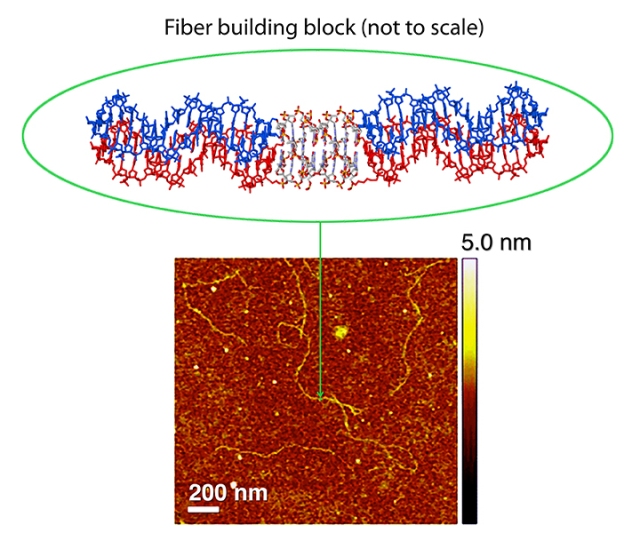Jul 25 2013
An international collaboration including researchers from the NIST Center for Nanoscale Science and Technology and the Universidad San Francisco de Quito, Ecuador have fabricated a self-assembled nanofiber from a DNA building block that contains both duplex (two-stranded) and quadruplex (four-stranded) DNA.
 Top: Schematic showing association of two duplex precursors into a quadruplex fiber building block. The duplex regions of the building block are shown in red and blue; the quadruplex region is shown in gray. Bottom: AFM image of quadruplex DNA nanofibers. These fibers can be 2 micrometers or more in length.
Top: Schematic showing association of two duplex precursors into a quadruplex fiber building block. The duplex regions of the building block are shown in red and blue; the quadruplex region is shown in gray. Bottom: AFM image of quadruplex DNA nanofibers. These fibers can be 2 micrometers or more in length.
This work is a first step toward the creation of new structurally heterogeneous (quadruplex/duplex), yet controllable, DNA-based materials exhibiting novel properties suitable for bottom-to-top self-assembly for nanofabrication, including self-organization of both inorganic materials (nanoparticles) and molecular electronics components.
The new nanofibers are constructed from duplex DNA precursors that first form quadruplex DNA in the presence of potassium ions and then connect together to form a fiber. DNA quadruplexes are unusual structures that can form from DNA sequences that are rich in the nucleotide guanine. Each strand in the duplex DNA precursor contains an internal run of eight guanines, which creates a region of guanine-guanine mismatches, plus one segment that extends past the duplex region to create a single-stranded overhang. When potassium ions are added, the duplex precursors self-assemble into quadruplex structures, and then into duplex/quadruplex fibers. These fibers were detected in bulk using electrospray mass spectrometry and gel electrophoresis. Single-molecule analysis using atomic force microscopy revealed fiber lengths ranging from 250 nm to 2000 nm. Because interaction between four strands of DNA takes place in some fiber segments, the final structures appear to be stiffer than DNA-based structures built from duplex-only subunits. This increased stiffness should lead to improved DNA patterning for nanotechnology applications. In contrast to DNA origami and DNA tile structures that are based solely on duplex DNA, the researchers believe that by varying the sequence of duplex and quadruplex subunits they ultimately will be able to create DNA building blocks that remain intact at temperatures ranging from room temperature to 100 ºC.
According to CNST Project Leader Veronika Szalai, this work will allow future integration with other programmable self-assembly methods such as DNA origami, as well as with other nanomaterial components such as quantum dots, to create new multi-functional biological-based nanomaterials.